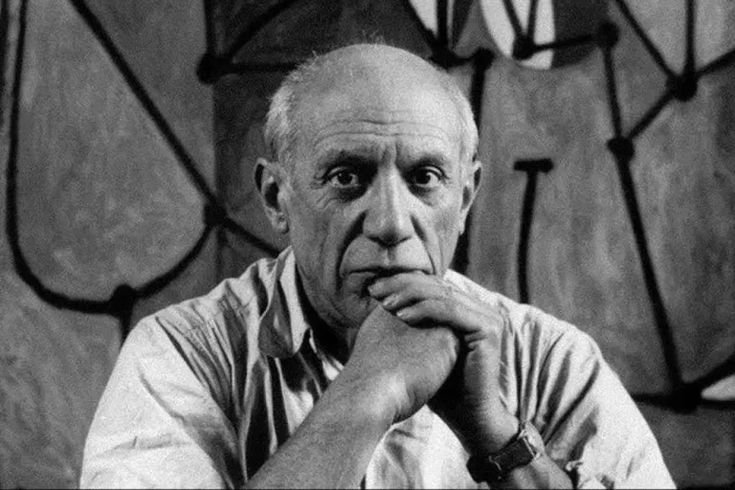- Early Life: The Formation of a Prodigy
- The Birth of Modern Art: Picasso’s Pioneering Achievements
- The Shadow Side: Picasso’s Troubled Relationships
- Psychological Dimensions of Genius
- Completing the Legacy of Pablo Picasso
- Ethical Implications of Picasso’s Greatness
- The Psychological Impact of Picasso’s Duality
- Lessons from Picasso’s Life
- A Legacy Beyond Art
- Conclusion
Pablo Picasso, a monumental figure in the world of art, redefined creativity with his revolutionary techniques and unmatched ingenuity. From his early years in Málaga, Spain, to his global recognition as a pioneer of Cubism and modern art, Picasso’s artistic journey is a story of brilliance, innovation, and unrelenting ambition. However, behind his celebrated genius lies a complex, often troubling narrative of personal flaws and moral shortcomings. His relationships, personality, and actions frequently exhibited a darker, “shadow side” that complicates his legacy.
Picasso’s life offers a fascinating exploration into the dualities of greatness—the ability to create groundbreaking art while grappling with ethical failings and personal struggles. By examining both the light and dark aspects of his character, we gain a deeper understanding of the human dimensions behind his extraordinary achievements.
Early Life: The Formation of a Prodigy
Born on October 25, 1881, Pablo Diego José Francisco de Paula Juan Nepomuceno Crispín Crispiniano María Remedios de la Santísima Trinidad Ruiz Picasso came into the world as the son of a painter and art teacher, José Ruiz Blasco, and María Picasso López. From a young age, Picasso demonstrated an extraordinary aptitude for art, producing advanced sketches that amazed those around him.
Artistic Upbringing
José recognized his son’s potential early on and took him under his wing, teaching him classical techniques in drawing and painting. By the age of seven, Picasso was already surpassing his father’s skills. This rigorous training provided a foundation in academic realism, though Picasso would soon rebel against such conventions.
By the time he was 14, Picasso had created some of his earliest masterpieces. However, this early success came at a price. His precociousness cultivated a sense of superiority, which would later manifest in both his professional life and personal relationships. His family moved to Barcelona in his teenage years, where Picasso’s talent gained him admission to the city’s prestigious School of Fine Arts.
Paris: The Cradle of Creativity
At 19, Picasso moved to Paris, the epicenter of the European art world in the early 20th century. Immersing himself in the city’s vibrant culture, he became part of an intellectual circle that included writers, poets, and other avant-garde artists. During this formative period, Picasso honed his unique style, absorbing influences from Impressionism and Symbolism while pushing boundaries.
His “Blue Period” (1901–1904), marked by somber tones and melancholic subjects, reflected his struggles with poverty and personal loss. This was followed by the “Rose Period” (1904–1906), where his works adopted warmer tones and explored themes of love and circus life. These early periods laid the groundwork for the revolutionary contributions Picasso would make in the coming decades.
The Birth of Modern Art: Picasso’s Pioneering Achievements
Picasso’s artistic contributions are unparalleled, with innovations that shaped the course of modern art. Over his lifetime, he produced an astonishing body of work—estimated at over 50,000 pieces—spanning paintings, sculptures, ceramics, prints, and drawings.
Cubism: Redefining Perception
Arguably Picasso’s most significant contribution to art, Cubism was a radical departure from traditional artistic representation. Co-developed with Georges Braque, this movement fragmented objects into geometric shapes, presenting multiple perspectives simultaneously. Works like Les Demoiselles d’Avignon (1907) challenged the conventions of perspective, space, and form, creating a new visual language.
Cubism’s influence extended far beyond visual art, impacting literature, music, and even architecture. It exemplified Picasso’s ability to break boundaries and redefine artistic expression.
Guernica: The Voice of Protest
In 1937, Picasso created one of his most iconic works, Guernica, in response to the bombing of the Basque town during the Spanish Civil War. The painting’s monochromatic palette and distorted forms conveyed the horrors of war in a way that transcended traditional methods of representation.
Guernica remains a powerful anti-war symbol, cementing Picasso’s role not only as an artist but also as a commentator on social and political issues.
Versatility and Reinvention
Throughout his career, Picasso continuously reinvented himself. From his forays into Surrealism in the 1920s to his later experiments blending abstraction and figuration, Picasso’s work defied categorization. This relentless innovation ensured his relevance in an ever-changing art world, solidifying his position as a leader in modern art.
The Shadow Side: Picasso’s Troubled Relationships
Despite his artistic brilliance, Picasso’s personal life was marked by volatility, infidelity, and emotional manipulation. His relationships, particularly with women, were often exploitative, reflecting his darker traits.
Women as Muses and Victims
Picasso had numerous romantic relationships throughout his life, many of which left emotional scars on the women involved. While they served as muses for his art, these women often suffered under his domineering nature.
- Fernande Olivier: Picasso’s first significant partner, Fernande was with him during his formative years in Paris. Their relationship, however, was tumultuous, characterized by jealousy and possessiveness.
- Marie-Thérèse Walter: At just 17 years old, Marie-Thérèse became Picasso’s lover while he was still married to Olga Khokhlova. Her youth and vitality inspired some of Picasso’s most sensual works, but his neglect and infidelity left her deeply hurt.
- Dora Maar: A talented artist and photographer, Dora Maar became one of Picasso’s most famous muses. Their relationship, marked by passion and volatility, ultimately led to Maar’s mental breakdown. Picasso’s treatment of Dora highlighted his tendency to prioritize his art over the well-being of his partners.
- Jacqueline Roque: Picasso’s second wife, Jacqueline, was devoted to him until his death. However, his controlling nature isolated her from others, and she tragically took her own life years after Picasso’s passing.
Family and Friends
Picasso’s domineering personality extended beyond his romantic relationships to his friendships and family. He was often emotionally distant from his children, demanding loyalty while providing little emotional support. His competitive nature also strained his friendships, including his collaboration with Georges Braque, which ended over disputes about credit for Cubism.
Psychological Dimensions of Genius
Picasso’s complex personality was both a source of his creative brilliance and his personal failings. His relentless drive for success often came at the expense of his relationships and emotional well-being.
Fear of Mediocrity
One of Picasso’s defining traits was his fear of mediocrity. This fear drove his constant experimentation and innovation, ensuring his artistic relevance. However, it also made him restless and difficult to satisfy, contributing to his turbulent personal life.
Narcissism and Control
Picasso’s self-centeredness and need for control were evident in his interactions with others. While these traits fueled his confidence as an artist, they also alienated those closest to him. His relationships often reflected a power imbalance, with Picasso asserting dominance over his partners, friends, and collaborators.
Completing the Legacy of Pablo Picasso
While the first part of this exploration delved into Picasso’s early life, artistic brilliance, and his darker personal side, the continuation further examines the psychological and ethical implications of his actions. Additionally, it highlights lessons we can draw from his complex legacy.
Ethical Implications of Picasso’s Greatness
Pablo Picasso’s towering presence in the art world came with significant ethical dilemmas. His treatment of women, appropriation of ideas, and use of power raise questions about the responsibilities of genius.
Exploitation of Power
Picasso’s fame afforded him significant influence over the lives of those around him. He often used this power to manipulate his partners and collaborators. His relationships with younger women, such as Marie-Thérèse Walter, highlight the imbalance in power dynamics. Picasso’s ability to charm and dominate not only affected his personal relationships but also extended to his professional dealings, where he sometimes overshadowed collaborators like Georges Braque.
Appropriation of Ideas
While Picasso was undoubtedly a genius, his relentless ambition occasionally led to accusations of overshadowing or appropriating the contributions of others. For instance, while Cubism is often attributed to Picasso, it was a collaborative effort with Braque. Picasso’s charisma and fame, however, ensured that his name became more closely associated with the movement.
Legacy in the #MeToo Era
Picasso’s relationships with women have come under renewed scrutiny in recent years, particularly in the context of movements like #MeToo. His behavior—marked by control, infidelity, and emotional neglect—has been reexamined as part of a broader conversation about the abuse of power in creative and professional environments.
The Psychological Impact of Picasso’s Duality
Picasso’s life exemplifies the psychological tension between creative brilliance and moral fallibility. His relentless pursuit of greatness often came at the cost of his emotional stability and relationships.
The Artist’s Inner Demons
Beneath Picasso’s confident exterior lay deep insecurities. His fear of irrelevance drove his constant reinvention, but it also fueled his need for control. This duality—between brilliance and insecurity—created a dynamic that shaped his life and art.
Impact on His Partners and Children
The emotional toll of Picasso’s personality extended to his partners and children. Several of his partners, such as Dora Maar and Marie-Thérèse Walter, suffered from mental health issues as a result of their relationships with him. His children, while benefiting from his financial success, often struggled to reconcile their admiration for his art with the emotional neglect they experienced.
Lessons from Picasso’s Life
Picasso’s legacy offers valuable lessons about the interplay of genius, ambition, and ethics.
Balancing Ambition with Empathy
Picasso’s story underscores the importance of balancing personal ambition with empathy and respect for others. While his drive for greatness propelled him to extraordinary heights, it also alienated those closest to him.
Recognizing the Complexity of Greatness
By examining both the light and shadow of Picasso’s legacy, we gain a more nuanced understanding of the complexities of human achievement. His life reminds us that even the most celebrated individuals are flawed, and their successes often come at a cost.
A Legacy Beyond Art
Picasso’s impact extends far beyond the realm of visual art. His innovations influenced literature, music, and even psychology, shaping the way we think about creativity and self-expression. However, his personal shortcomings serve as a cautionary tale about the ethical challenges of fame and influence.
Picasso as a Cultural Icon
Even decades after his death, Picasso remains a symbol of artistic innovation and freedom. His works are celebrated in museums and exhibitions worldwide, and his influence can be seen in the work of countless contemporary artists.
Reassessing the Artist in Modern Times
As society continues to evolve, so too does our understanding of Picasso’s legacy. While his artistic achievements are undeniable, the ethical dimensions of his life prompt us to reevaluate the ways we celebrate greatness.
Conclusion
Pablo Picasso’s life encapsulates the dualities of human nature: unparalleled creative brilliance and profound personal flaws. His contributions to art revolutionized the way we perceive and create, yet his relationships and ethical decisions reveal the darker side of his character.
Picasso’s story is both inspiring and cautionary. It reminds us that greatness often comes with complexities that must be acknowledged and understood. By exploring his shadow side, we gain a richer, more holistic understanding of his legacy, celebrating his achievements while learning from his shortcomings.



